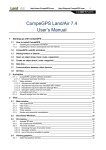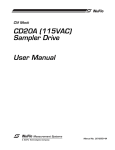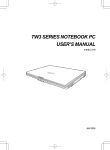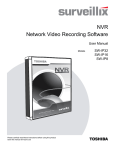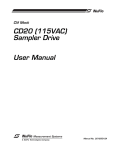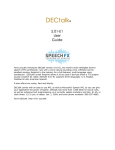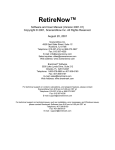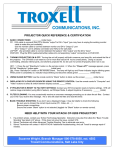Download User Manual (LAN) - Reading Horizons
Transcript
User Manual Reading Horizons Discovery™ User Manual Reading Horizons Discovery™ User Manual, Network Published by Reading Horizons 60 North Cutler Drive, Suite 101 North Salt Lake, UT 84054 800-333-0054 Printed in the United States of America Copyright April 2014 by Reading Horizons No part of this publication may be reproduced, stored in a retrieval system, or transmitted in any form or by any means, electronic, mechanical, photocopying, recording, or otherwise, without the prior permission of the copyright owner. ISBN 978-1-62382-105-0 Table of Contents Software Overview 1 Network Installation 2 Server Installation 2 Client Installation 7 Administration System 9 Class Roll 11 Adding and Editing Students 11 Options Tab 12 Groups Tab 15 Overrides Tab 15 Set Global Options 17 Reports 18 Class Roll Report 18 Student Summary Report 19 Common Core Report 20 Student Lesson Summary Report 21 Lesson Summary Report 22 Student Test Summary Report 23 Test Summary Report 22 Assessment Summary Reports 25 Phonemic Awareness Assessment Summary Report 25 MCW Assessment Summary Report 27 Spelling Assessment Summary Report 28 Spelling Vocabulary Summary 30 Student Library Summary 31 Administrators 32 Adding and Editing Administrators 32 Advanced 33 Preview Content 34 Online Resources 35 Export Students 35 Import Student Tool 36 Message Center 37 Student Software Overview 39 i ii Software Overview The Reading Horizons Discovery™ software guides students through a series of one of four tracks: Kindergarten (K), Grade 1 (1), Grade 2 (2), and Grade 3 (3). Item Instances by Grade K Track Track 1 Track 2 Track 3 Chapters 2 4 5 6 Letter Lessons 26 5¹ 5¹ 5¹ Standard Lessons 13 38 53 58 Most Common Word Lessons 8² 18³ 21³ 22³ Reference Lessons 7 14 15 15 Little Book Stories 10 44 59 64 Vocabulary Word Walls 2 4 5 6 Tests 7⁴ 4 5 6 K Track Track 1 Track 2 Track 3 Phonemic Awareness⁵ 7 7 7 7 Most Common Word⁶ 3 5 6 7 Spelling/Word Recognition 1 3 4 4 Assessments 1. Letter Lessons for tracks 1-3 are taught in groups (A,B,F,D,G), (H,J,L,M,E), (N,P,R,S,O), (T,V,W,X,Y,U), (Z,Q,I,C,K). 2. MCW Lessons for Kindergarten cover the top 30 Most Common Words from the Fry Word List. 3. MCW Lessons for Tracks 1-3 cover the top 220, 280, and 300 Most Common Words from the Fry Word List, respectively. 4. The seven Kindergarten tests are much shorter are given more frequently than tests from Tracks 1-3. 5. Instruction precedes the Kindergarten Phonemic Awareness Assessments. For Track 1 instruction will follow if assessments are failed (i.e. less than 66%). These assessments are overridden by default for Tracks 2 and 3. 1 Network Installation The Reading Horizons Discovery™ program is available as a network application when properly loaded on a local server/client environment. The following system requirements must be met in order to guarantee optimal use of the software: LAN Server Windows Vista®, 7, 8, Windows Server® 2003, 2008, 2012, Intel Based Mac OS X v10.6 or later 1.5GHz processor 512MB of RAM 4 GB hard drive space DVD drive Server Installation Begin by inserting the Reading Horizons Discovery™ DVD-ROM into a DVD drive on the network server. Access the disc’s folder menu, and select either “setup-windows.exe” or “set-up-osx” to start the install process. If the server is using a Windows operating system, select “setup-windows.exe.” If the server is using an OSX operating system, select “setup-osx.” - Use this file for servers using a Windows-based operating system. - Use this file for servers using an OS X-based operating system. 2 When the following screen appears, press “Next” to continue. Read the license agreement provided, select the desired option, then press “Next.” 3 Enter the license key provided with the software (dashes included), then press “Next” to continue. The license key will be validated. If the key is invalid, check for errors, and try again. Verify that the installation options shown are correct, and make any needed corrections. If you are not sure what the settings should be, leave the default settings as they are, then press “Next.” 4 If you are instructed to enter another port for the Web Service or Database, please do so, then press “Next.” Please call Reading Horizons for technical assistance if you do not know which port to use. Enter the site details in the fields provided, then press “Next.” Confirm that the install path is correct and that enough disk space is available, then press “Next.” 5 Press “Next” to start the installation. The installation time will vary depending upon the hardware used. The green bar tracks the installation progress. The installation time will vary depending upon the hardware used. 6 Press “Finish” to complete the installation process. Client Installation Place a copy of the shortcut file, Discovery, created in the installation directory (example C:\Program Files\Reading Horizons\Discovery 5) on the desktop of each client computer that will be using the software. The program will run through a web browser (see the requirements listed below for compatible browsers). Each client computer should meet these minimum system requirements: Windows 1. 2 .33GHz or faster x86-compatible processor, or Intel® Atom™ 1.6GHz or faster processor for netbooks 2. M icrosoft® Windows Server® 2003 (32 bit), Windows Server 2008 (32 bit), Windows Vista® (32 bit), Windows Server 2012 (32 bit), Windows 7 (32 bit and 64 bit), or Windows 8 (Classic and Modern) 3. Internet Explorer 7.0 or later, Mozilla Firefox 4.0 or later, Google Chrome, or Safari 5.0 or later 4. 5 12MB of RAM (1GB of RAM recommended for netbooks); 128MB of graphics memory 7 Mac OS • Intel Core™ Duo 1.83GHz or faster Intel processor • Mac OS X v10.6, v10.7, v10.8, or v10.9 • Safari 5.0 or later, Mozilla Firefox 4.0 or later, or Google Chrome • 512MB of RAM; 128MB of graphics memory Please contact the Reading Horizons support line with any questions or concerns regarding the network installation (800333-0054). 8 Administration System The Administration System is designed to help administrators and instructors track students’ progress as they advance through the program. It is included with the software and can be accessed from any computer connected to the server. Logging In 1. Click on the Reading Horizons Discovery™ shortcut provided. 2. Enter your user ID, and press “Login.” 3. T he system will recognize your user ID, and your administrator account name will be displayed. Enter your password in the field provided. 9 Trouble Shooting: • If you forget your password, please call Reading Horizons support at 800-333-0054. • Passwords are alphanumeric (must contain at least one letter and one number), have a minimum of eight characters, and can include symbols. Administrator Access There are two levels of administrators: Instructor and Site. An Instructor has access only to those students assigned to the instructor. A Site Administrator has access to all of the students within the site. The access provided for each level is shown in the table below. Class Roll Students – add, edit, delete students Groups – add, edit, delete groups Reports Advanced – Lesson Preview Tool/Import Message Center Administrators – add, edit, delete admins Sites – add, edit, delete sites Seat Management 10 Instructor x x x x x x Site x x x x x x x Class Roll The Class Roll tab is the default tab. This tab shows the list of students to which the administrator has access. The list can be sorted by any of the column headers and can also be filtered by instructor (site level access only), group, or track. From this tab, it is possible to add, edit, and delete students and groups. Adding and Editing Students (to edit multiple students, see Set Global Options below) 1. C lick on the “Add Student” or “Edit Student” button. 2. A dd or edit the student’s information. Fields with an asterisk (*) must be completed. Note: The username is what the student will use to access the software. This should be something easily remembered. A name or student ID number the student uses for schoolwork is suggested. The username is not case sensitive. 3. E dit the student’s options. (See the Options Tab section on the following page for more details.) 4.Assign the student to group(s). (See the Groups Tab section on the following pages for more details.) 5. S et lesson overrides (if desired). (See the Overrides Tab section on the following pages for more details.) 6. C lick on the “Save Student” button to apply the changes. 11 Options Tab Grade Track – Select from K, 1, 2, or 3. Track 3 is the default track. Lesson Track – Select from Instruction Track or Activities Track. Activities track will skip the instruction portion of a lesson. If the activities are failed, the instruction is given followed by the activities a second time. Lesson Passing Percentage – This is the percentage correct required to complete a lesson. If a score lower than this is achieved, the student will be given a refresher followed by the activities. If the student passes the activities, the lesson status is set to yellow. If the student fails the activities, the lesson status is set to red, and a message is sent to the message center. MCW Passing Percentage – This is the percentage correct required to complete a lesson but also the minimum score required during the MCW Assessment that will override a MCW List Lesson. Test Passing Percentage – This is the percentage correct required to pass the individual lesson skills being tested. For skill scores lower than this percentage, the student is given the lesson refresher followed by the activities. If the student passes the activities, the status is set to yellow. If the student fails the activities, the status is set to red, and a message is sent to the message center. Assessment Timers – This is the time (in seconds) given to a student for each word in the MCW and Word Recognition Assessments. 12 Activities Decoding Selection – When this option is enabled, the student will be shown multiple decoding marks, one of which is correct, during the activities. The student must select the correct mark. Selecting the wrong mark counts as a wrong answer and is part of the score. This feature is disabled by default. Vocabulary Decoding Selection - When this option is enabled, the student will be shown multiple decoding marks, one of which is correct, while proving words on the Word Walls. The student must select the correct mark. Selection of the wrong mark counts as a wrong answer. This feature is disabled by default. Enable Library – This gives the student access to the library. Enable Vocab – This gives the student access to the vocabulary word walls. Enable Games – This gives the student access to the game cupboard. Enable Store – This gives the student access to the Clubhouse Store. Enable Color Overlays – Some students may benefit from specific background colors when reading words on the screen. This feature allows the administrator to select the color overlay that is best for the student. The overlay will be used during lessons, tests, and assessments. Allot Coins – This will show the current amount of coins a student has earned. It will start out at 0 by default. We discourage the practice of gifting credits to students, as that will diminish the value of the coins and will not encourage work within the software. However, we recognize the potential this 13 feature allows for rewarding good behavior and/or excellence in the classroom. Recurring Free Game Day – By default, the student uses 15 coins to buy 15 minutes of game time. The days of the week that are checked are free game days. An instructor may choose to make the weekend days free game days to encourage use of the software at home. Specific Free Game Day – Set the current day as a free game day by selecting the “Set As Today” button, or select the calendar icon to designate a day in the future as a free game day. To remove the day, select “Clear.” Daily Store Time Limits – When selected this feature will enable Max Store Time and Min Courseware Time options. Max Store Time – This will limit the amount of time a student can spend in the store without spending time on the courseware. When the max store time limit has been spent the store will be locked until the Min Courseware Time is achieved. Min Courseware Time – This is the amount of time that must be spent each day on the courseware to allow unlimited access to the store. The store time and courseware time counters are reset each night. Store Accessible Days – This allows the administrator to control when the store is available to the students. All days are selected by default. 14 Special Day Access – Set the current day as a special access day by selecting the “Set As Today” button, or select the calendar icon to designate a day in the future as a special access day. To remove the day, select “Clear”. Groups Tab Select from the list of available groups on the right, and press “<<” to add the student to the group. The student is a member of each group listed in the Group Membership list on the left. To assign a student to multiple groups at the same time, hold down the “Ctlr” key (non-sequential selection) or the Shift key (sequential selection) and select the desired groups, then press “<<”. To remove a student from a group or groups, select the group(s) and press “>>”. Overrides Tab In the Overrides tab, the sequence of instruction is shown for each chapter, including assessments, lessons, and tests. A status box, shown to the left of each item, indicates the status of that item. The status codes are, as follows: White – Yet to be completed Black – Overridden Green – Completed Yellow – Completed with some difficulty Red – Failed 15 The buttons found at the bottom function, as follows: Override – This button is used to override items in the instructional sequence. An item that is overridden will be skipped. To override specific items, select the desired item or items. If selecting multiple items, hold down the Ctrl key for non-sequential selection or the Shift key for sequential selection. Then press the “Override” button. The status box for each item will be set to black. Clear – This button is used to clear the status box of an item that has been overridden (black) or to clear a red or yellow status item (yellow or red when cleared will change to green). Select the item or items. If selecting multiple items, hold down the Ctrl key for non-sequential selection or the Shift key for sequential selection. Then press the “Clear” button. Set Next – This button is used to quickly set the next item in the students’ instructional sequence. Select the item to be next, and then press “Set Next.” All preceding items that have a white status will be overridden (this includes items in preceding chapters, as well). Reset – This button is used to clear results for items with a status of green, yellow, or red. Select the item or items, and then press the “Reset” button. Caution: Using the Reset button will permanently delete the scores for lessons, tests, and assessments. The item will need to be completed again. 16 MCW – This button is used to override all Most Common Word (MCW) lessons. Press the “MCW” button. The status for all MCW lessons in all the chapters will be changed to overridden (black). Alphabet – This button is used to override all alphabet lessons. Press the “Alphabet” button at any time. The status for all alphabet lessons will be changed to overridden (black). This includes the Alphabet Introduction and individual letter lessons for K track and the letter group lessons for tracks 1-3. Reference – This button is used to override all reference lessons. Press the “Reference” button at any time. The status for all reference lessons will be changed to overridden (black). Assessments – This button is used to override all assessments. Press the “Assessments” button at any time. The status for all assessments will be changed to overridden (black). This includes Phonemic Awareness, MCW, and Spelling/Word Recognition Assessments. Filters The Class Roll and Reports can be filtered by Instructor, Group, and/or Track. To set a filter, click on a filter selection field, and select the desired option. To clear the filter, click the “clear filter” text above the filter selection box. It is important to note that the selected filters will limit the students that are shown in the Class Roll as well as within the Reports tab. Set Global Options (editing multiple students at the same time) 1. S elect the students to be edited by either pressing the “Select All” button at the bottom of the list or by holding down the Ctrl key (for non-sequential selection) or the Shift key (for sequential selection). Then press the “Set Global Options” button. 2. C lick on the check box, make the desired changes, and repeat for other items. 3. P ress “Save.” (Note: Students who are logged in cannot be edited.) 17 4. Press “Hide Global Options” to close the global options window. Note the following exceptions to global editing: • Assign Track Lesson is not available if selected students are on different tracks. • Assign Track Lesson will not override current status codes. • Assign Track Lesson is not the same as Set Next Lesson. In this case, no items are overridden. The selected group will be forced to take the indicated item next, but upon completion of that item, they will each return to the item they were learning prior to the change. • Add Game Credits is not enabled for global editing. CAUTION: Use Assign Track Lesson carefully. If students are in the middle of a test or lesson and Assign Track Lesson is used globally, the students’ progress in the test or lesson is lost. Upon completion of the item set as the Track Lesson, the students would start at the very beginning of the test or lesson. Reports The Reports tab contains the following reports: Class Roll, Student Summary, Common Core, Lessons Summary, Tests Summary, Assessments, Vocabulary Summary, and Library Summary. Please note that the filters set on the Class Roll tab will apply to the reports. Class Roll Report The Class Roll Report is the default report. This report shows all the students to which the administrator has access. The Report Banner across the top shows several measurements and averages for the group being shown. The first section shows the Common 18 Core completion average, followed by the average progress as well as the group average time and total time spent in the software. The body of the report can be sorted by any of the first seven columns. The columns are, as follows, from left to right: Students – The first and last names of the students. The report is sorted alphabetically according to this column by default. RTI Status – This shows the status of the student. Sort by this column to quickly see which students require intervention. The status codes are, as follows: On Track Student is on track Caution Three or more yellow status codes Alert One or more red status codes Time in Software – Shows student’s total time in the software Last Login – Shows the date when the student last accessed the software. Track – The student’s track (K, 1, 2, or 3) Current Lesson – The student’s current lesson Percentage Complete – The percentage completed of the instructional sequence for the assigned track Chapters 1–6 – A graphical representation of the total track (represented by the grey bar) and the percentage complete (represented by the blue bar). This progress bar also shows the student’s current chapter. Student Summary Report To access this report, simply double-click on one of the students in the Class Roll Report. To return to the Class Roll Report, press the “Back” button. The Report Banner is displayed across the top on this report, as well, but the data shown is for the selected student. A summary is provided for each of the following sections: Lessons, Tests, 19 Assessments, Vocabulary, and Library. Each section is designed to provide a quick summary for how a student is performing in each area. To see more detail for a particular section, simply click anywhere within that section. To change the current student, click on the drop-down box with the student’s name, and select another student. Common Core Report To access the Common Core Report, click on the Common Core link in the Report Banner. To return to the Class Roll Report, press the “Back” button. The Common Core Report shows a percentage complete for each grade level of the Common Core (the percentage complete only includes the items from the Common Core which the software covers for the Foundational Skills and Language Standards sections). The grade for the assigned track is highlighted and is also the percentage reported on the Student Summary Report. The total points earned within each of the Common Core grade levels is shown on the blue bars (for more information about how the point values were determined please click on the information icon within the Common Core Report). To see the list of Common Core items covered and the associated lesson(s), click on one of the blue bars and then one of the green bars. The report will expand to show the specific Common Core items, a list of lessons that correlate to that item, the total points earned, the total points available, and the percentage complete for each item. Lessons that are not yet complete are shown in light grey while lessons that are complete are shown in black. To minimize a section, simply click on the section header again. 20 Student Lesson Summary Report This report shows the status and results for the lessons given through the course of the software. To access this report, click on the “Tests” section of the Student Summary Report. Press the “Back” button to return to the Student Summary Report. The Student Lesson Summary Report shows the Report Banner for the selected student. The body of the report can be viewed by selecting either the “All Chapters” tab or one of the individual chapter tabs (e.g. Chapter 1, Chapter 2). The columns for the report are, as follows, from left to right: Lesson Number (^) – This lesson number corresponds to the lesson numbers in the direct-instruction materials. Lesson Title – This is the full title of each lesson. RTI Status – Shows the status of the lesson. Sort by this column to quickly see with which lessons the student struggled. The status codes are, as follows: Lesson has been successfully Completed completed Failed the first time but passed Caution following the refresher Failed both times; a message is sent Alert to message center By an administrator or from Overridden assessment results Not Taken Lesson has not been taken Score – Percentage correct in lesson activities. Note that some lessons, when completed, will have no score. This is because those lessons have no activities associated with them. 21 Overall – The sum of the correct and total answers Skills in Isolation – Shows how the student performed on skills in isolation. There are no skills in isolation for MCW lessons. Skills in Context – Shows how the student performed on skills in context. Spelling – Shows how the student performed in spellingrelated activities. Only MCW lessons will have spelling results. Rapid Recognition – Shows how the student performed in rapid recognition activity. Only MCW lessons will have rapid recognition results. Time – Shows total time spent in the lesson. Date – Shows the date the lesson was completed. The footer of the report shows the sum for all of the scores, the student’s overall percentage and total time, as well as the average overall percentages and time for the group being shown. Lesson Summary Report To access this report, double-click on one of the lessons in the Student Lesson Summary Report. To return to the Student Lesson Summary Report, click on the “Back” button. The Lesson Summary Report shows the lesson status and results for all students. View a different lesson by clicking on the dropdown box and selecting another lesson. 22 Student Test Summary Report This report shows the status and results for the tests given through the course of the software. To access this report, click on the “Lessons Tests” section in the Student Summary Report. The body of the report can be viewed by selecting either the “All Tests” tab or one of the individual test tabs (e.g., Test 1, Test 2). When viewing the All Tests tab, the individual tests are displayed on each line. Test Summary Report To view the Test Summary Report, double-click on one of the test titles from the All Tests tab. The Test Summary report shows the test status and results for all students. View a different test by clicking on the test name drop-down box and selecting another test. 23 Major Skill Summary Report When viewing the individual test tabs (e.g., Test 2), you are viewing the Major Skill Summary Report. The major skills tested are displayed on each line (as shown below). Minor Skill Summary Report To view the Minor Skill Summary Report, double-click on one of the major skills listed. The minor skills report shows how the student scored on each individual element of a skill. Some major skills have only one minor skill, while some have many minor skills, as is the case with L-Blends shown below. The columns for these reports are, as follows, from left to right: Original Sort (^) – This column allows you to get back to the original sort. 24 Lesson Title – Shows the title of the test. RTI Status – Shows the status of the test. Sort by this column to quickly see with which tests the student struggled. The status codes are, as follows: Completed Test has been completed Skill(s) failed in test but passed Caution following refresher Skill(s) failed both times; message Alert sent to admin. Overridden Override was set by an administrator Not Taken Test has not been taken Score – Percentage correct in test. Overall – The sum of the correct and total answers. Skills in Isolation – Shows how the student performed on skill in isolation. Skills in Context – Shows how the student performed on skills in context. Reference – Shows how the student performed in reference lesson activities. Refresher – No results posted unless the student fails a skill. Time – Shows total time spent in the test. Date – Shows the date the test was completed. The footer shows the sum for all of the scores, the student’s overall percentage and total time, as well as the average overall percentages and time for the group being shown. Assessment Summary Reports To access these reports, click on the “Assessments” section in the Student Summary Report. The tabs from which to choose are: Phonemic Awareness, MCW Assessments, and Spelling/ Word Recognition. The Phonemic Awareness tab will be shows by default. Phonemic Awareness Assessment Summary Report This report shows the status and results for the seven phonemic awareness assessments. 25 The columns for this report are, as follows, from left to right: Original Sort – This column allows you to get back to the original sort. Lesson Title – Shows the title of the assessment. RTI Status – Shows the status of the test. Sort by this column to quickly see with which assessments the student struggled. The status codes are, as follows: Completed Assessment has been completed Less than 66 percent correct – Caution student may need help Override was set by an Overridden administrator Not Taken Assessment has not been taken Score – Percentage correct. Overall – The sum of the correct and total answers. Time – Shows total time spent in the assessment. Date – Shows the date the assessment was completed. Class Average – Shows the average score for the group being shown. The footer of the report shows the sum of the overall scores, the student’s overall percentage and total time, as well as the average overall percentages and time for the group being shown. The graph shows the student’s score (blue bar) against the class average (red line) for each assessment. 26 Double-clicking on each assessment will show the results for each student in the current group. MCW Assessment Summary Report This report shows the results for the MCW Assessments completed by the student. The columns for this report are, as follows, from left to right: Lesson Title – Shows the title of the assessment. Score – Percentage correct. Overall – The sum of the correct and total answers. Highest List – Shows the highest MCW list assessed. Time – Shows total time spent in the assessment. Date – Shows the date the assessment was completed. The footer of the report shows the student’s best score and total time, as well as the average best and average total time for the group being shown. The graph shows the student’s score (blue bar) together with the highest list achieved (red line) for each assessment. Double-clicking on an assessment will show the results for each list. 27 Double-clicking on a list will show the individual word results for each list. Spelling Assessment Summary Report This report shows the results for the Spelling/Word Recognition Assessments completed by the student. The columns for this report are, as follows, from left to right: Lesson Title – Shows the title of the assessment. Score – Percentage correct. Overall – The sum of the spelling and word recognition scores. Spelling – Shows the points earned in the spelling portion of assessment. Word Recognition – Shows the points earned in word recognition portion. Skills Passed – Number of skills for which the student demonstrated mastery within the assessment (66 percent or higher in overall skill score). Time – Shows total time spent in the assessment. Date – Shows the date the assessment was completed. 28 The footer of the report shows the student’s best scores, highest count of skills passed, and total time. It also shows the average best and average total time for the group being shown. The graph shows the student’s score (blue bar) together with the skills passed (red line) for each assessment. Double-clicking on an assessment will show the results for each assessment. The columns for this report are, as follows, from left to right: Test Order – The sequence in which the words are given in the assessment. Spelling Word – The word given in the assessment. Spelled – Shows how the student spelled the word. Score – Percentage of total points the student earned. Overall – The sum of the spelling and word recognition scores. Spelling – Spelling points earned. Word Recognition – Points for identifying the word correctly. Skill – The skill columns that follow show the skill elements being tested. Point – Points for correctly spelled skill in the correct position. Toggle the report from Words to Skills to see the report details sorted by the skills. 29 The columns for this report are, as follows, from left to right: Lesson Number – This lesson number corresponds to the lesson numbers in the direct-instruction materials. Skill Lesson – This is the lesson title. RTI Status – This shows the status of the skill. Sort by this column to quickly see with which skills the student struggled. The status codes are, as follows: The instruction portion of this Skill Passed lesson is overridden. The student may need help with Caution this skill. The student does not understand Alert the skill. All of the skill elements were not Not Tested assessed. Score – Percentage of total points the student earned. Overall – The sum of the spelling and word recognition scores. Spelling – Spelling points earned. Word Recognition – Points for identifying the word correctly. Skill – The skill columns that follow show the skill elements being tested. Point – Points for correctly spelled skill in the correct position. Student Vocabulary Summary This report shows the student’s completion information for each Word Wall. To access this report, click on the “Vocabulary” section in the Student Summary Report. The report shows for each word 30 wall the percentage complete, the number of words on the wall, the total possible, the date of last activity, and the number of words added over time (24 hours, week, 2 weeks, month). Student Library Summary This report shows the student’s results for each story assessment. To access this report, click on the “Library” section in the Student Summary Report. The body of the report can be viewed by selecting either the “All Chapters” tab or one of the individual library tabs (e.g., Kinder, Ch. 2). When viewing the All Chapters tab, all of the books for which the students will have access in their assigned tracks are shown. The columns for this report are, as follows, from left to right: Story Order – The sequence in which the stories are unlocked in the software. Story Title – The title of the Little Book story. RTI Status – This shows the status of the story. Sort by this column to quickly see with which stories the student struggled. The status codes are, as follows: 31 A score of 66 percent or better for all attempts. A score between 34 – 65 percent for all Caution attempts. A score of 33 percent or worse for all Alert attempts. Not Story has not yet been unlocked for Unlocked student. Score – Percentage correct. Overall – The sum of all scores. Main Idea – Score for questions pertaining to the main idea of the story. Detail – Score for questions regarding the details of the story. Vocabulary – Score for questions pertaining to vocabulary used in the story. Inference – Score for questions that test what can be inferred from the story. Story Grammar – Score for questions pertaining to the story grammar. Sequence – Score for questions pertaining to the sequence of events. Time – Shows total time spent in the story. Date – Shows the date the story assessment was first completed. On Track Administrators The Administrators tab shows the list of administrators to which the current user has access. From this tab, it is possible to add, edit, and delete administrators. Adding and Editing Administrators 1.C lick on the “Add” or “Edit” Administrator button. All fields must be completed. 2.Enter the first and last names. 3.Enter the e-mail address. This will also be auto-filled as the username. 32 4.E nter the password. The password must be at least eight characters long, must contain one letter and one number, and can include symbols. 5.Confirm the password. 6. Choose the administrator type; Instructor or Site. 7. A dd site access. Select the site from the right-hand list; press “<<” to grant access. 8. C lick on the “Save Administrator” button to apply the changes. Advanced The Advanced tab options are Manage Users, Preview Content, Online Resources, Export Students, Import Students, and Import Administrators. Manage Users This options shows you a list of current users. At times it may be necessary to manually logout a student. To do this, select the desired student, then press the “Logout Student” button. 33 Preview Content This tool allows an administrator to view a lesson, test, or assessment in whole or in part and to interact with the software just as the student would. It also allows an administrator to interact with the Vocabulary Word Walls and to spell and decode words as well. To view a lesson: 1. Select the desired track 2. Choose the desired lesson types 3. Click on the desired lesson 4. Choose the desired sections 5. Press the “Play” button 34 To view the Vocabulary Word Walls, click on the “Play” button in the Vocab section at the bottom of the screen. Online Resources On this page you will find links to valuable resources. Export Students This feature allows for an export of a full student record that can be imported into another account or site. To export students: 1. U se the Instructor, Group, and Track filters to refine the list of available students 2. S elect the students to be exported using the shift+select or control+select method (click “Select All” to select the entire list). 3. P ress “>>” to add selected students to the export list. 4. Press “Export Selected Students” to start the export process. 5. When student export data is compiled click “OK” to continue. 6. C hoose the desired file location, change the name as needed, then press “Save”. 7. Click “OK” on the Export Complete pop-up. 35 Import Student Tool This import tool is capable of importing full student records from Reading Horizons Discovery version 5.0 and higher (.rhdx file extensions) as well as importing lists of new students (.csv file extensions). To import students: 1. Click on the “Exported File (.rhdx)” or the “Delimited File (.csv)” button. 2. A file browser window will open. Select the .rhdx or .csv file that contains the data to be imported, and press “Open”. For .rhdx imports skip to step 4 and for .csv imports continue to step 3. 3. The delimited Import Configuration window will open. a. If the first row of the import file contains column headers, check the box. b. Select the delimiting character. A comma is most common. c. The tool will attempt to auto-map the data as best as possible. If no headers match the field name on the left, then the mapping must be done manually. To map the field, click on the drop down box and select the corresponding column title from the list. d. When all the data is mapped correctly, press the “OK” button. 36 4. T he new students will be listed in the Students Available for Import column on the left. Select the students to be imported by pressing the “Select All” button or by holding down the control key (for non-sequential selection) or the shift key (for sequential selection) while selecting. Then press “>>”. 5. If desired, select from the drop-down menus the instructor and/or a group to which the selected students will be assigned. 6. W hen all the students to be imported are in the Students Selected for Import column on the right, press the “Import Selected Students” button. Message Center This tab contains all the messages generated by the software. Messages are generated when a student fails a lesson or portions of a test. The messages can be sorted by type, student name, subject, or date. 37 The selected message will show in the reading pane at the bottom of the page and will offer three action options: Delete Message – Once a message is deleted it cannot be retrieved. To clear flags or reset items after a message is deleted, edit the students’ overrides under the Class Roll tab. Clear Failed Flag - To remove the red RTI status for the item in reports, press this button. Once the flag has been cleared or a reset performed, deleting the message is the only option. Reset Lesson - To delete results and reset the item status, press this button. Once the flag has been cleared or a reset has been performed, deleting the message is the only option. 38 Student Software Overview The Clubhouse – There are seven options for students to click on once they have entered the clubhouse: Next, Vocabulary, Library, Games, Dashboard, Tutorial, and Exit. Next – This will always take the student to the next item (lesson, test, etc.) in the instructional sequence. Vocabulary (chalkboard) – When the student has progressed far enough to spell and prove words, the vocabulary tool can be accessed. A word wall for each chapter will be unlocked, and the student can practice spelling and proving words from completed lessons. The pronunciation tool can be accessed by first clicking on the chalkboard and then the “ABC Draw” sign. 39 Dashboard (name plate) – Students can click on their name plates at any time to see their dashboards. The dashboard is a quick way to see progress through the current chapter (the map), trophies earned for completed chapters, and the number of coins in the treasure trove. A link to the Clubhouse Store is also provided in the dashboard. Clubhouse Store – When the store is enabled the student can enter by click on the store sign or the treasure trove. The student can use the coins they earn to purchase new items for the clubhouse. Students can now customize the clubhouse and make it their own. 40 Games (dartboard) – Games are unlocked as the student progresses through the software. The coins are used to purchase game time. Each game is designed to reinforce skills learned in a fun and interactive way. Library (books) – As the students complete lessons, the stories are unlocked in the library. The student can access all unlocked books at any time. Tracks 1-3 students will have the K track stories in their libraries from the very beginning. The student is given a set of comprehension questions the first time the story is read in conjunction with the lesson and the first time it is read from the library. After a book has been read in the library, a gold coin appears on the spine of the book, which means the book can be read as often as desired, and the student has the choice to have the story read by a narrator. 41 Tutorial (compass) – Clicking on the compass will replay the introductory video explaining the features of the Clubhouse. Exit – This logs the students out of the software and returns them to the sign-in page. Other Items – The other items in the Clubhouse (i.e. pirate ship, sword and shield, safari jeep, dinosaur and volcano, and the cowboy hat) are collected as the student completes each chapter. Lesson Flow Assessments – When the students first use the software, they will be given a series of assessments. They are, as follows: Phonemic Awareness: These seven assessments identify the student’s ability to recognize phonemes — rhyming, syllables, initial sounds, blending, final sounds, medial sounds, and segmentation. Most Common Words: This assessment, given at the end of each chapter, asks the student to identify the most common word spoken from among three choices. As the student identifies words correctly, the software will modify the lesson plan accordingly by overriding the corresponding MCW lists. If 42 the student misses three words in a row or correctly identifies fewer than 40 percent of the words in a list, the assessment will end. Spelling – Word Recognition: This assessment, given at multiple intervals throughout the software, asks the student to spell a list of words. After the spelling test, the student is asked to identify the spoken word from among three choices. The software then evaluates each answer and gives the student a score based on the different skill elements found in each word. The student may spell a word incorrectly but can still earn points for certain skills. For example, the word is cliff, and the student spells it clif. The student will get points for the cl blend. If the student scores high enough (lesson passing percentage) on any particular skill, the instruction portion of that lesson will be skipped. The student will go straight to the activities for the lesson. If the student scores no points for three words in a row, the assessment will end. Lessons – There are three basic lesson types in the software: Standard, MCW, and Reference. The standard lessons will cover the alphabet and the skills. The MCW lessons cover the Most Common Words lists. The reference lessons cover things like nouns, verbs, etc. and vary by track. To see settings that will effect lessons, see the following section in this manual: Options tab, Overrides tab, and Set Global Options. Chapter Tests – A test is given at the end of each chapter to measure the student’s understanding of the skills taught. A student earns a chapter trophy for each test. Mini-Games – We have added mini-games to the software. Students will get the chance to play one of three mini-games at various places in the software. The mini-games help to break up long assessments, lessons, and tests. 43 44

















































